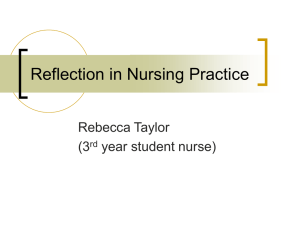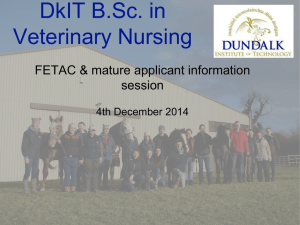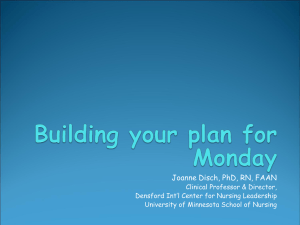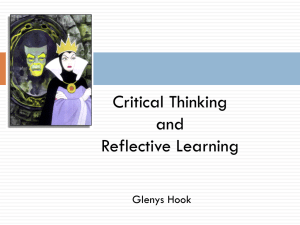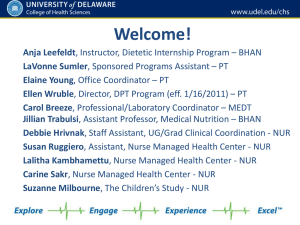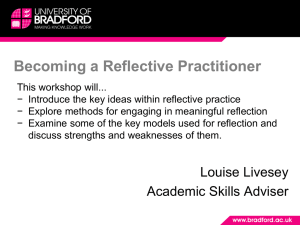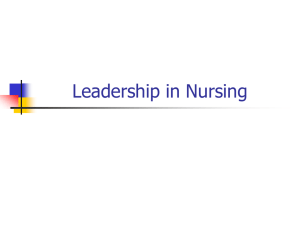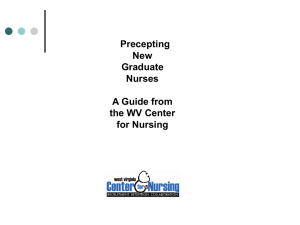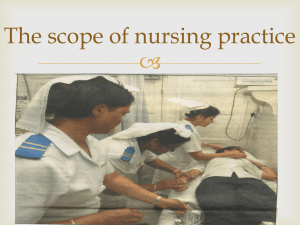195_MEDEV_lecture___portfolio_SPullen
advertisement
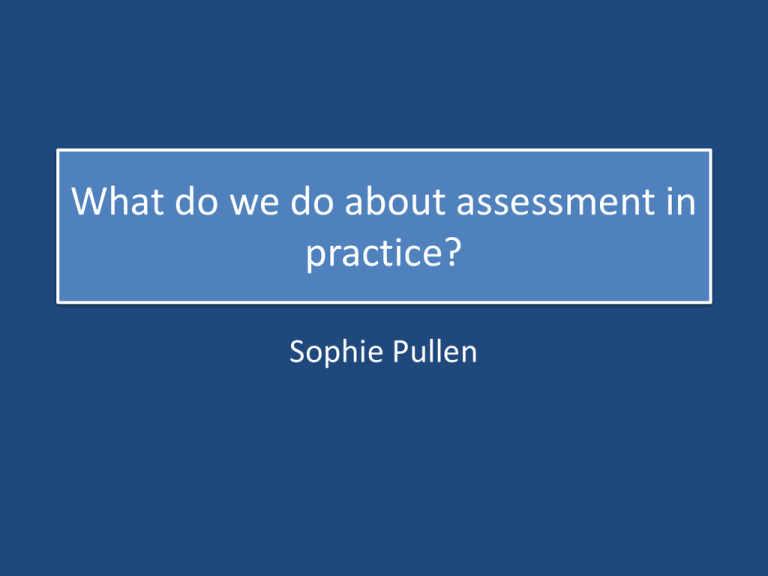
What do we do about assessment in practice? Sophie Pullen Objectives of a course in HE The broad aims of the Foundation Degree in Veterinary Nursing are to: • Produce a safe, competent and reflective Veterinary Nurse who is eligible for admission to the RCVS Veterinary Nurse Register • Produce a critical thinking practitioner with extensive knowledge, who can contribute to the standing of the Veterinary Nursing profession through subject specific preparation • Produce Veterinary Nurses with a wider range of skills, enabling them to work in a variety of roles within Veterinary practice (RVC, 2009) Portfolio system • Shopping trolley • Toast rack • Spinal column • Cake mix (Timmins et al, 2008) Backwash: the effect of assessment on learning • Backwash: when the assessment rather than the curriculum, determines learning. • It implies that what the students learn and how they learn depends very much on what they think they will be assessed on . (Biggs 1995 cited in Tiwari and Tang, 2003) The NPL Nursing Progress Log • We know that this is to be introduced • We understand it will be supported by a ‘clinical coach’ Benner: novice to expert • Novice • Advanced • Competent • Proficient • Expert Theory-practice divide • ‘A major dilemma of curriculum development in nurse education is whether is should focus on ‘nursing as it is’ or on ‘nursing as it should be’ (Mead, 1999) The move into HE suggesting the second is endorsed: theory – practice gap? What could we do? Add an element of reflection? Sayer (1990) – described reflective thinking as ‘...the artistry of combining a professional repertoire with current clinical problems to invent unique responses’ Characteristics of reflective practitioners (Schon) The effective reflective practitioner has the... – ability to engage in self assessment – ability to criticise the existing state of affairs – ability to promote change and adapt to change – ability to act as an autonomous individual – ability to recognise and explore confusing or unique events How do we do this? ‘A portfolio in which there is a reflective component, may provide a tangible bridge between theory and practice.’ (Severinsson, 1998) Reflective Journals/diaries • Journals provide a very useful tool from which to explore beliefs and values in terms of your own experience’ • They can also provide a valuable teaching tool when used during individual tutorials or group discussions (Hinchliff, 2004) Marland and McSherry 1997 A diary had the following positive effects: • It enhanced time management between student and preceptor • It promoted reflective learning • It facilitated the transferability of insights gained in one situation or placement to others • It allowed students to see how they were progressing • They concluded that the use of a reflective diary provided a ‘framework for analysis and discussion’ and formed a link between theory and practice. Critical incident analysis • Benner (1984) stated that a critical incident could be: An incident... – – – – – – In which the nurses intervention made a difference that went unusually well where there was a breakdown that was typical or ordinary that captured the essence of nursing that was particularly demanding Discussion boards? • Reed and Proctor (1993) found that ‘sharing experiences has a positive effect on learning’ • In order to learn from critical incidents students in one study were encouraged to share their reflections in small peer groups. Guided reflection Discussion boards? • Glen and Hight (1992) describe the tutor as a ‘resource’ for the student in reflecting on experiences and subsequent development. (Cited in Harris et al, 2000) Student comment ‘I felt exhausted both mentally and physically. I felt frustrated. I could not give the patients my full attention’ Reflective comment.. What constraints are present in your workplace which prevent you from giving the care you would like to give to each patient? (Adapted from Taylor, 2000) Communication is essential Student Mentor/coach University The use of models Should we use one? ‘Students may be reluctant to share personal information with their peers and tutors’ (Harris et al, 2001) Remember.... Models are there to provide guidance . They are not meant to be ‘rules’ for reflection. Veterinary nurses should be encouraged to ... ‘develop a flexible approach to their use, giving some thought to which parts of the model are most useful...’ (Heath, 1998) Rolfe’s Reflective model (2001) based on Borton’s model (1970) What? This is the description and self awareness level and all questions start with the word what So What? This is the level of analysis and evaluation when we look deeper at what was behind the experience. Now what? This is the level of synthesis. Here we build on the previous levels these questions to enable us to consider alternative courses of action and choose what we are going to do next. Examples What happened? What did I do? What did other do? What was I trying to achieve? What was good or bad about the experiences Examples So what is the importance of this? So what more do I need to know about this? So what have I learnt about this Examples Now what could I do? Now what do I need to do? Now what might I do? Now what might be the consequences of this action? Gibbs Reflective Cycle (1988) Description Action plan Feelings Evaluation Conclusion Analysis Interestingly… • ‘Students who report negative experiences were more likely to outline their feelings’ • ‘Students in the more senior years were more likely to use a cycle and move beyond the first phase of reflection, whereas the junior students, particularly the first years were more likely to confine reflection to the first phase of Gibb’s’ (Timmins et al, 2008) What do we do with this information? Do we mark it? How do we mark this? Summative or formative? • There are issues of validity and honesty of written accounts, particularly when summative assessment requires the assignment of a grade.’ (Timmins et al, 2008) Adopt a portfolio marking criteria? Investigate those used within human nursing? Whatever we do the following points need to be considered …... Considerations…… • Clear guidelines needs to be provided • A suitable mentor/coach is essential • Students should to continue being supported by College/University staff • A suitable placement environment is required – belongingness. • There is a potential to identify legal and ethical issues occurring in practice. • Issues of confidentiality References - portfolio • Gannon, F. T., Draper, P. R., Watson, R., Proctor, S. and Norman, I. J., 2001. Putting portfolios in their place. Nurse Education Today 21, 534 – 540. • Harris, S., Dolan, G. and Fairbairn, G., 2001. Reflecting on student portfolios. Nurse Education Today. 21, 278286. • McCready, T., 2005. Portfolios and the assessment of competence in nursing: A literature review. International journal of nursing studies 44, 143-151. References - portfolio • McMullan, M., 2008. Using portfolios for clinical practice learning and assessment: The pre-registration nursing student’s perspective. Nurse Education Today 28, 873 – 879. • Storey, L. and Haigh, C., 2002. Portfolios in professional practice. Nurse Education in Practice 2, 44-48. • Timmins, F. and Dunne, P. J., 2009. An exploration of the current use and benefit of nursing student portfolios. Nurse Education Today 29, 330-341. • Tiwari, A. and Tang, C., 2003. From process to outcome: the effect of portfolio assessment on student learning. Nurse Education Today. 23, 269 – 277. References - reflection • Burns, S and Bulman, C., 2000. Reflective Practice in Nursing: the growth of the professional practitioner 2nd edn. Oxford: Blackwell Science. • Duffy, A., 2008. Guiding students through reflective practice – the preceptors experiences. A qualitative descriptive study. Nurse education in practice. • Heath, H., 1998. Keeping a reflective practice diary: a practical guide. Nurse Education Today 18, 592-598. • Hinchliff, S., 2004. The practitioner as teacher 3rd edn London: Elsevier. References - reflection • Taylor, B. J., 2000. Reflective Practice: a guide for Nurses and Midwives, Milton Keynes: Open University Press. • Teekman, B., 2000. Exploring reflective thinking in nursing practice. Journal of Advanced Nursing 31(5), 1125 – 1135. • Quinn, F. M., 2000. The Principles and Practice of Nurse Education, U.K.: Stanley Thornes (Publishers) Ltd.
